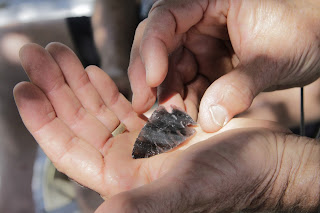Patience was the primitive toolmaker’s greatest resource. It
took time to knap a blade, or grind the edge of a stone adze. Once it was
fashioned and put to use, however, the tool freed up time and energy that could
be put to other uses. Mechanical leverage was another important aspect of tool
making. A hand axe, a blade fashioned from stone, in the hand of an experienced
worker could chop through wood well enough, but mounting the tool to a handle
gave leverage, and therefore increased force. Fields could be cleared of trees
and plants more easily, substantially advancing the spread of agriculture.
The same was true for hunting weapons. A spear could be
thrown with only so much force, but creating a lever extended the reach of the
throwers arm, increasing the mechanical force and the weapon’s penetrating
power. Such leverage was the advantage of using an atlatl, or spear-throwing
stick of the kind attendees of the Stone Age Olympics will witness first-hand
this month.
 |
| Master flint knapper, Ken Peek |
Stone tools first appear in the archaeological record more
than 100,000 years ago, but most of the tools we now associate with the “Stone
Age” were perfected in the Neolithic period (New Stone Age), approximately
10,000 to 3,000 years ago before the use of copper and later bronze made stone
tools if not obsolete, less widely employed. The dates at which societies adopted metal
technology varies, in general, the Neolithic Revolution (a term coined by
Australian archaeologist Vere Gordon Chile) saw the transformation of
hunter-gatherer societies into settled agrarian ones. Some of mankind’s first
tools were used for hunting, but with the advent of settled life, animal
husbandry, and agrarian societies, the techniques learned from weapon making were
turned to the practical project of fashioning adzes for hewing wood, digging tools
for turning the soil, and finer tools that aided in making pottery, fashioning
clothes, and preparing food.
 Weapon making never ceased to be important, however, as
settled societies tended to be easy targets for resource-hungry tribes. The advantages
of settled society in terms of resource sharing, more stable social structures
and increased life span outweighed the risk of attack. Settlement in areas
close to water usually put societies in close proximity to game, and increased
protein intake, and the raising of animals for food was a significant step in
the stabilization of large areas. Increased productivity meant more mouths to
feed, but also meant the establishment of villages, towns, and ultimately
city-states in the bronze era. The pattern of settlement and society building
finds parallels in the Mediterranean, Middle Eastern, and Eurasian contexts.
Weapon making never ceased to be important, however, as
settled societies tended to be easy targets for resource-hungry tribes. The advantages
of settled society in terms of resource sharing, more stable social structures
and increased life span outweighed the risk of attack. Settlement in areas
close to water usually put societies in close proximity to game, and increased
protein intake, and the raising of animals for food was a significant step in
the stabilization of large areas. Increased productivity meant more mouths to
feed, but also meant the establishment of villages, towns, and ultimately
city-states in the bronze era. The pattern of settlement and society building
finds parallels in the Mediterranean, Middle Eastern, and Eurasian contexts.
In some parts of the world where game and wild foods were
abundant, such as certain parts North America, hunter-gatherer societies had
less pressure to cultivate than others, though some Native Americans developed
better strains of wheat and corn. Moreover, for people such as the Ohlone,
metal technologies only appear with the arrival of Europeans, hence, their
traditional tool-making skills continued to develop and get passed on.
 When park naturalist Dino Labiste started the Stone Olympics
2011, he had been thinking of “an event that would bring out families.” There
had been some weekend events prior to that and Labiste decided to build on
those, turning them into a single annual event with experts in fire-making,
stone tools, and hunting techniques, including the “rabbit stick” and the
atlatl such as the native Ohlone people would have used alongside bows and
arrows here in the Bay Area. “Every year the attendance picks up, “ says
Labiste, and 2015’s event drew “about 150 people.” So-called “primitive”
technologies are often misunderstood, for it is easy to misjudge their
effectiveness because “we simply do not live with them every day as our ancestors
would have.”
When park naturalist Dino Labiste started the Stone Olympics
2011, he had been thinking of “an event that would bring out families.” There
had been some weekend events prior to that and Labiste decided to build on
those, turning them into a single annual event with experts in fire-making,
stone tools, and hunting techniques, including the “rabbit stick” and the
atlatl such as the native Ohlone people would have used alongside bows and
arrows here in the Bay Area. “Every year the attendance picks up, “ says
Labiste, and 2015’s event drew “about 150 people.” So-called “primitive”
technologies are often misunderstood, for it is easy to misjudge their
effectiveness because “we simply do not live with them every day as our ancestors
would have.”
Along with Labiste, flint-knapping expert Ken Peek will be
on hand to demonstrate stone tool making, as will Mark Dellinges, atlatl expert
(Dellinges can be found on YouTube, https://www.youtube.com/user/markdel3.
There you can see his videos of atlatl demonstrations).
Stone Age Olympics
Sunday, Sep 25, 2016
10:00 a.m. – 12:15 p.m. and 1:00 p.m. – 3:00 p.m.
Coyote Hills Regional Park
8000 Patterson Ranch Rd
(Meet at Dairy Glen Campground)
(510) 544-3220
dlabiste@ebparks.org
http://www.ebparks.org
Open to the public – event is free
Parking is $5.00

No comments:
Post a Comment